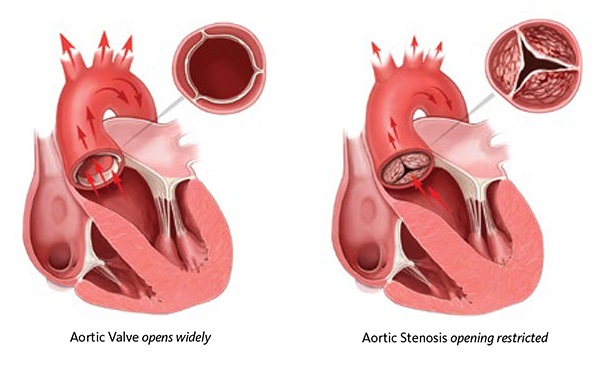Aortic Stenosis
Aortic stenosis, also called aortic valve stenosis, is a common problem that can develop in many individuals as they get older. Over time, the aortic valve of the heart (one of four valves) can become thickened and stenotic, meaning that it is too narrow and doesn't open very well. This causes blood flow from the heart into the rest of the body to be obstructed, forcing the heart to work overtime to pump sufficient blood. People with aortic stenosis may develop symptoms such as shortness of breath with activity, chest pain, extreme fatigue, heart palpitations or even light-headedness.
The only effective, long-term treatment for aortic stenosis is a valve replacement. Several types of aortic valve replacement are available: standard, minimally invasive and transcatheter aortic valve replacement. Your surgeon and cardiologist will determine and recommend the best procedure for you.

Aortic Stenosis Causes, Symptoms and Progression
Aortic stenosis is one of the most common and serious valve disease problems. Listen as Dr. Joshua Rovin, a cardiovascular surgeon and director of the Center for Advanced Valve and Structural Heart Care at Morton Plant Hospital, discusses the main symptoms, causes and progression of aortic stenosis.
How Does Aortic Stenosis Develop?
As individuals age, calcium deposits can collect around the aortic valve. This calcification leads to thickening and narrowing of the valve's opening - aortic stenosis. Sometimes people are born with a variety of abnormal congenital conditions that may also lead to the development of aortic stenosis; rheumatic fever may also cause stenosis of the aortic valve.
When the valve's opening is constricted, the left ventricle, which pumps blood out of the heart, has to work harder and suffers from increased pressure. This extra effort causes the ventricle walls to become thicker, which may cause chest pain. As the pressure grows in the ventricle with nowhere for the blood to go, some blood may back up into the lungs.
Symptoms of Aortic Stenosis
The symptoms of aortic stenosis may include:
- Breathlessness with activity
- Chest pain, or angina:
- Crushing, squeezing, pressure, tightness
- Pain increases with exercise, is relieved with rest
- Pain is felt under the chest bone but may move to other areas, most often the left side of the chest
- Fainting, weakness, or dizziness with activity
- Sensation of feeling the heart beat too quickly or irregularly (palpitations)
Call your health care provider if you have symptoms of aortic stenosis. For example, call if you or your child experiences heart palpitations for more than a short period of time. Palpitations may feel like the heart is "pounding" or "racing," beating too slowly, or beating at an irregular rhythm. Also, contact your doctor immediately if you have been diagnosed with this condition and your symptoms get worse or new symptoms develop.
Diagnosing Aortic Stenosis
When you visit your healthcare provider, he or she may order a variety of tests, based upon your symptoms, to confirm your diagnosis. Tests may be performed in the office or in another healthcare setting ( imaging department, cardiac catheterization lab, etc.). Tests that may be performed include:
- Chest x-ray
- Doppler echocardiography
- ECG
- Exercise stress testing
- Cardiac catheterization
- Transesophageal echocardiogram (TEE)
Types of Aortic Stenosis
Mild Aortic Stenosis
Monitoring your health with your health care provider is always a good idea even if you do not display any symptoms of aortic stenosis. If your symptoms are mild, observation may be all that is required. If you’ve been diagnosed with aortic stenosis, your health history should be monitored and you should receive an echocardiogram (heart ultrasound) along with your annual physical exam.
Severe Aortic Stenosis
Once patients develop severe aortic stenosis, they will start to develop symptoms of shortness of breath, particularly with exercise, chest discomfort, palpitations, and light-headedness. If you have been diagnosed with severe aortic stenosis, patients are often referred to a cardiothoracic surgeon for evaluation of treatment options.
Aortic Stenosis Treatment Options
Aortic stenosis may cause heart failure. Medications are prescribed to manage the symptoms of heart failure; they will not cure the condition. Commonly prescribed medications include:
- Diuretics (water pills)
- Nitrates
- Anti-hypertensive medications
Surgery to repair or replace the valve is the preferred treatment for individuals who have developed moderate to severe symptomatic aortic stenosis. Prior to recommending surgery, the cardiothoracic surgeon will evaluate test results and recommend one of the following procedures:
- Standard aortic valve replacement
- Minimally invasive aortic valve replacement
- Transcatheter aortic valve replacement via a transfemoral approach
- Transcatheter aortic valve replacement via a transapical approach
The new transcatheter aortic valve replacement (TAVR) procedure offers a new option for patients who, in the past, were not deemed candidates for surgery. TAVR is a revolutionary new option that offers a replacement of this valve without putting high-risk patients through an open-heart procedure.
In those patients who have been diagnosed with aortic stenosis, the next step is to follow up with their primary care physician as well as their cardiologist. Your health care professional will most likely suggest a referral to the The Center for Advanced Valve and Structural Heart Care at Morton Plant Hospital, the St. Joseph’s Hospital Structural Heart Valve Program or the Structural Heart and Valve Program at Winter Haven Hospital at which time patients are thoroughly screened and evaluated to see if they would be a candidate for this new technology.
Patients in Tampa, Clearwater, St. Petersburg, Winter Haven and throughout the Tampa Bay area can learn more about transcatheter aortic valve replacement by calling (855) 233-0888.


